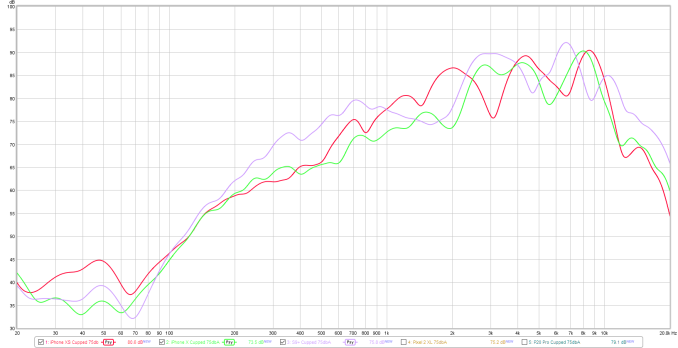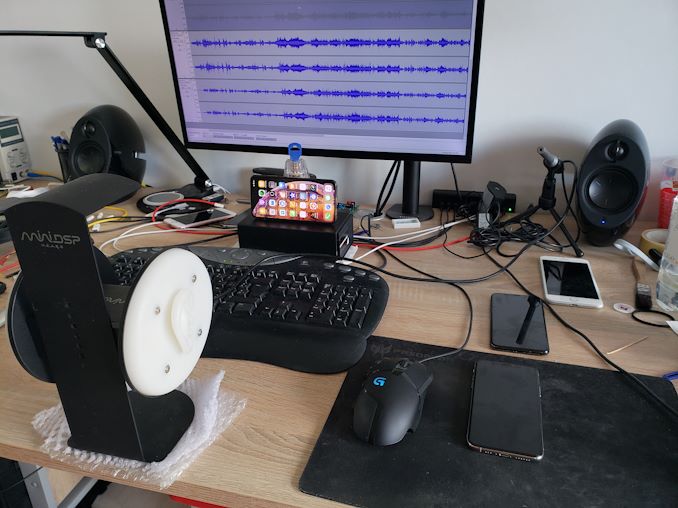The iPhone XS & XS Max Review: Unveiling the Silicon Secrets
by Andrei Frumusanu on October 5, 2018 8:00 AM EST- Posted in
- Mobile
- Apple
- Smartphones
- iPhone XS
- iPhone XS Max
Camera Video Recording
In terms of video recording, the iPhone XS promises an improved dynamic range in modes up to 30fps. What this likely means is that the phone’s able to capture in HDR mode in the 30fps modes, doing the same kind of processing we also see in SmartHDR still pictures.
Also something I’ve dreaded on iPhones for years; the new iPhone XS finally introduces stereo audio recording. Why it took Apple such a long time to finally introduce stereo recording is something that boggles the mind, but, let’s not complain, as we now finally have it on the new generation.
iPhone XS: iPhone X:
Comparing the iPhone XS video to the iPhone X, there’s one thing that is immediately very evident: the new XS is able to produce much better image stabilisation than last year’s flagship. Indeed, it looks like Apple vastly improved the OIS/EIS on the new phones, as the wobble that happens when walking is gone on the XS.
Audio recording finally is up to par, and we can hear the wind and rustling leaves of the trees around us. I think Apple might still have to work a bit on the wind noise cancellation, as in some parts the audio sounded as if it was inside a tube.
In terms of image quality, Apple’s claims of the improved dynamic range are very much verified. The phone showcases a lot more brought down highlights in the scene, and in darker areas, show better shadows. It’s unfortunate that this is limited only to the 30fps modes, but it’s understandable.
Switching over from the main lens to the telephoto lens happens relatively fast, although with a short exposure flash and a slight delay on the first zoom. 4K60 recording doesn’t allow for the use of the telephoto lens.
All in all, the video recording quality of the new iPhone XS is massively improved in all areas of stabilisation, picture quality, and audio. 4K30 recording on the XS is probably the best I’ve seen on any smartphone – a definitive applause to Apple for the improvements here.
Speaker Evaluation
Apple claimed to have improved the speaker audio quality on the new iPhone XS, allowing for more stereo separation and filling sound. I had introduced a new speaker evaluation method a few months ago because this year’s efforts by smartphone vendors to improve speaker quality has been very pronounced, and I wanted to have a way to objectively convey these improvements.
Starting off with speaker loudness, we’re measuring the phones at maximum volume, both in one-hand portrait mode, as well as two-handed mode where the palms are cupped towards the user. These two use-cases are what I find myself most often using the phone’s speakers in, so hopefully that also represents how most users use it as well, please let me know otherwise!

Using a pink noise signal, the iPhone XS pretty much falls into line with the results of the iPhone X, coming in at a very loud 82.8dBA in portrait mode and 87.6dbA in two-handed mode. Apple’s sound directionality on the iPhone X and XS is among the best, most likely due to the fact that the stereo earpiece is among the loudest of current generation smartphones.
Measuring the frequency response of the speakers, we see the iPhone XS closely following the measurement of the iPhone X, however there’s a major difference in the mid-range where the XS is around 5dB louder, raising instrumental frequencies and voices. This difference is what I think Apple is referring to when talking about better “fullness”, as it is evident when playing back media.
To better demonstrate the difference between the phones, I’ve attempted to capture them with a binaural microphone setup. Now I know my environment isn’t perfect as I don’t have the necessary sound dampening equipment, but I hope it does serve as an overall adequate A/B comparison between the phones. I’ve tried to calibrate the sound as much as possible recorded by the setup to a flat frequency response, although I’m sure there are improvements to be made. As a comparison, I also included calibrated speakers as a baseline to get an idea of the microphone setup.
The audio is meant to be listened to with headphones, or even better with IEMs, as this will give the intended playback of the binaural recording.
The iPhone XS’ improvements in the mid-range are quite evident as voices sound deeper and more pronounced on the new phone. Stereo separation is also quite good – resulting in a filling audio experience.
I included the S9+ and G7 as comparison devices. Samsung still does a significantly better job at the low-mid ranges which gives the phone more overall presence than the iPhones, also has an advantage in the very high frequencies giving more clarity, however the new iPhone’s XS strength point in the mid-ranges is the S9’s weakness, and vocals sound a lot less present than on the XS.
As for the G7, I just wanted to showcase a mono speaker device, and just how huge the audio difference is. Unfortunately the G7, even though it promises to have a good speaker, fails in practice.












253 Comments
View All Comments
NICOXIS - Friday, October 5, 2018 - link
I wonder how A12 would do on Android or Windows... I'm not into Apple but they have done a fantastic job with their SoCLiverpoolFC5903 - Tuesday, October 9, 2018 - link
Probably nowhere as good as it is projected here.What is the bloody point of these supposedly super fast SOCs with massive caches and execution units when the OS running on it will be the highly limited, crippled and locked OS like the IOS. No emulators, no support for USB peripherals like gamepads, mice or keyboards, poor excuse for file management, no access to outside apps, no ability to run non webkit based browsers, no ability to seamlessly transfer data to and from windows desktops and multiple other limitations.
All and well getting excited over this SOC but its like Having a 450 BHP ferrari running on a 80 mile speed limiter with an automatic transmission. All that power is useless and will remain unutilised.
Until they allow other OS to run on their hardware, the comparisons are meaningless. I can do a hell lot more on a pithy 835 than I will ever be able to do on an A11 or A12.
iSeptimus - Tuesday, October 9, 2018 - link
Wow, so much wrong with this statement.bulber - Friday, October 12, 2018 - link
You are wrong and I know you are too narcissistic to realize that. I would pity you but your username tells me you don't deserve any pity.Barilla - Friday, October 5, 2018 - link
Fantastic hardware (well, except the notch), shame it's only locked to one OS. Would love to see an Android phone with hardware like that.Matte_Black13 - Friday, October 5, 2018 - link
Well Qualcomm is working on quite a few things, new SoC, NPU, and Samsung is totally redesigning their GPU, so...maybe sooner than later (S10)varase - Friday, October 5, 2018 - link
It'll be interesting to see what comes of that effort - so much of the Android market is feature phone replacements - the actual percentage which represents high end flagship phones is pretty slim.If a bigger percentage of the Android market is willing to pay for silicon with that increased compute capacity, there may be hope.
melgross - Saturday, October 6, 2018 - link
But will they? Microprosser Reports says that each new SoC from Apple cost, the year of introduction, between $34-38. Top Android SoCs cost between $24-28. That’s a big difference. These phones compete wither each other, and price while Apple mostly competes against itself.melgross - Saturday, October 6, 2018 - link
The reason, or I should say, one of the reasons why other manufacturers are copying Apple’s notch, is because it allows a full screen phone. Notice that Samsung has edge to edge, but still retains a shorter screen on both the top and bottom. The notch removes 2-3% of the screen area, depending on screen size, which is very little. Now take the Galaxy 9+, and you’ll notice that when the entire top and bottom cutoffs are added together, it amounts to about 10% of the possible screen size.It’s why the new Pixel and others are moving to the notch. In the cases where the notch is just being copied, it’s ridiculous, because those companies are still using a chin on the bottom, and the notch is just there to copy the iPhone.
id4andrei - Saturday, October 6, 2018 - link
No. They are copying the iphone for the look. If they were copying to maximize screen area they would copy Essential. Apple removed the chin and the notch is needed for face id - they have a good reason. Some copycats(not all) ape the look and keep the chin. A good compromise is the impending OnePlus T. It has teardrop notch and minimized chin that makes it look actually good. Asus is on the other side of the spectrum. They even bragged they wanted to copy the look of the iphone X.